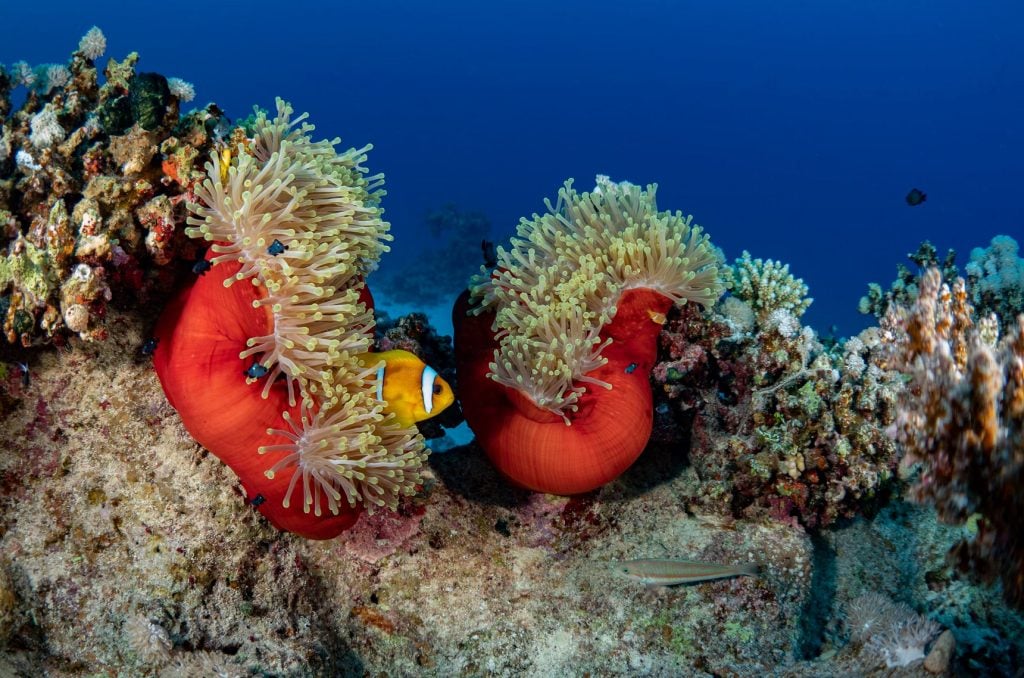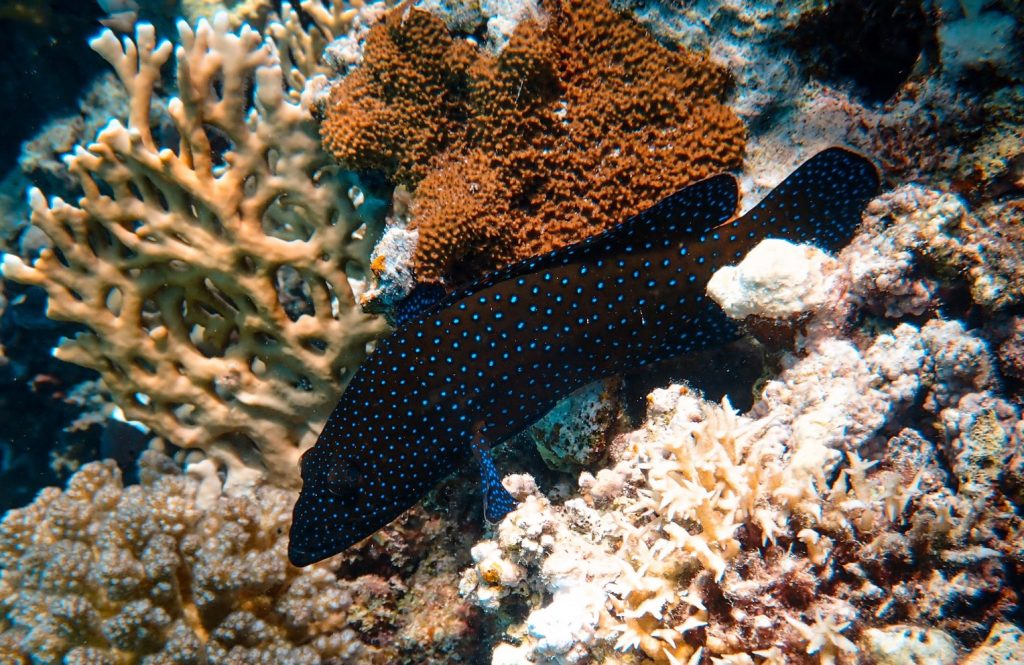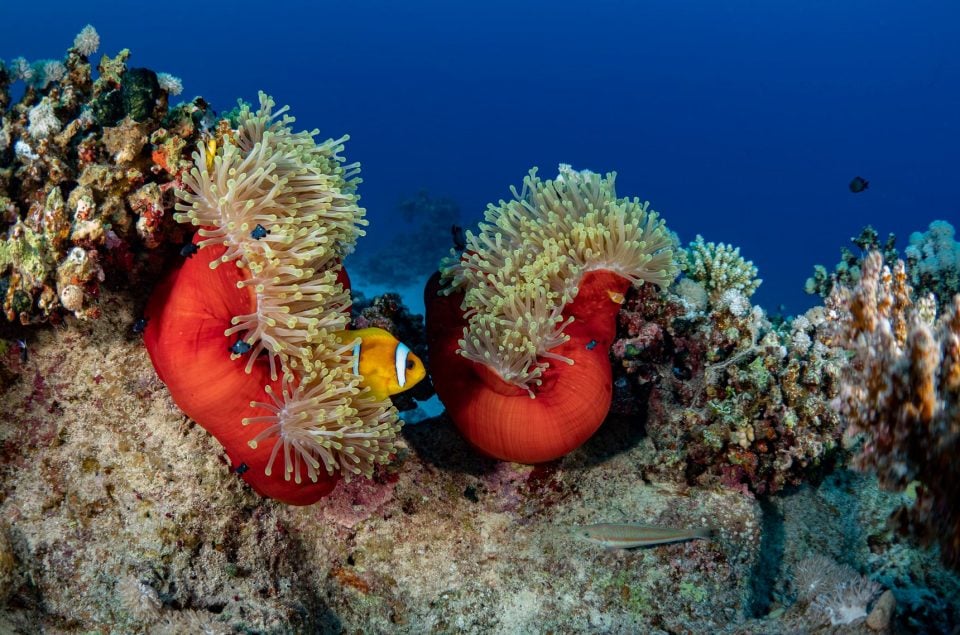
Ready to make a splash this Global Scuba Day (6 August)? Celebrate by diving into the wonders of the Red Sea, where WWII wrecks, vibrant coral gardens, and thrilling marine encounters await. Whether you’re an adventure junkie or a serene explorer, here are our top ten dive sites to explore:
- Elphinstone Reef
Elphinstone Reef, 30km from Marsa Alam, is famed for its steep walls, coral gardens, and abundant shark sightings, including oceanic white-tips and hammerheads. The reef’s strong currents and depth make it suitable for experienced divers. Its diverse marine life and dramatic underwater scenery are key highlights. The best times to dive is October – December.
- Blue Hole, Dahab
The Blue Hole is an iconic dive site known for its deep 130m sinkhole and challenging conditions that are only suitable for advanced and technical divers, it features a descent through a tunnel called “The Bell” and a stunning reef wall. The Blue Hole’s mysterious allure and unique topography make it a bucket-list destination for many divers.
- Shark and Yolanda Reef, Ras Mohammed
Located in Ras Mohammed National Park, these twin reefs are renowned for their vibrant marine life and stunning coral formations. The site features strong currents, making it an excellent drift dive. 200m down, divers can explore the remains of the Yolanda, a cargo ship that sank in 1980, alongside a plethora of fish and coral species. This site is easily accessible from Sharm el-Sheikh.
- SS Thistlegorm Wreck
The SS Thistlegorm is one of the most famous wreck dives in the world. Sunk in 1941 by German bombers, this WWII cargo ship is an underwater museum filled with motorbikes, trucks, and railway carriages. Discovered by Jacques Cousteau in the 1950s, it remains a must-visit for wreck diving enthusiasts. The site is usually accessed via liveaboard, with trips from Sharm el-Sheikh or Hurghada offering multiple dives to explore this historical marvel.
- Thomas Reef, Straits of Tiran
Part of the four reefs in the Straits of Tiran, Thomas Reef is celebrated for its deep canyons and diverse marine life. Divers can encounter large gorgonian fans, black coral, and a variety of shark species. The site offers exciting drift dives, making it a favourite among experienced divers visiting Sharm el-Sheikh.

- Daedalus Reef, Marsa Alam
90km off of Marsa Alam, sits Daedalus Reef known for its pelagic species and pristine coral formations. It’s a top spot for seeing hammerheads, thresher sharks, and manta rays. This hidden gem is one of the lesser visited sites and is within a protected Marine park ensuring less crowded dives and well-preserved underwater landscapes
- Brothers Islands
The Brothers Islands, also known as El Ikhwa comprise of the 400m ‘Big Brother’ and approximately 200m ‘Little Brother’ islands offshore from Al Qusair. Known for its shark encounters and vibrant coral reefs, they also have two notable wrecks to explore, the Aida II and the Numidia. Due to the currents and conditions, this dive site is for advanced divers only, requiring 50 dives under your belt to dive there.
- Fury Shoals
Fury Shoals, located in the southern Red Sea, offers some of the most pristine coral gardens and diverse marine life. The area is less frequented by divers, providing a serene underwater experience. Common sightings include white-tip sharks, manta rays, dolphins, and occasionally dugongs. The site is accessible from Marsa Alam and caters to a variety of diving abilities.
- Jackson Reef, Straits of Tiran
Jackson Reef is the northernmost reef in the Straits of Tiran and is known for its rich coral gardens and abundant marine life. One of the most popular dive sites, the strong currents attract large schools of fish and various shark species. The site also features the wreck of the Lara, adding an element of exploration for advanced divers. It is typically accessed from Sharm el-Sheikh
- The Canyon, Dahab
The Canyon, located near the Blue Hole in Dahab, is a popular dive site featuring a deep fissure in the seabed. Divers enter through a large opening and explore the crack illuminated by sunlight. The Canyon’s unique geological formations and the surrounding reef make it a memorable recreational dive experience.



